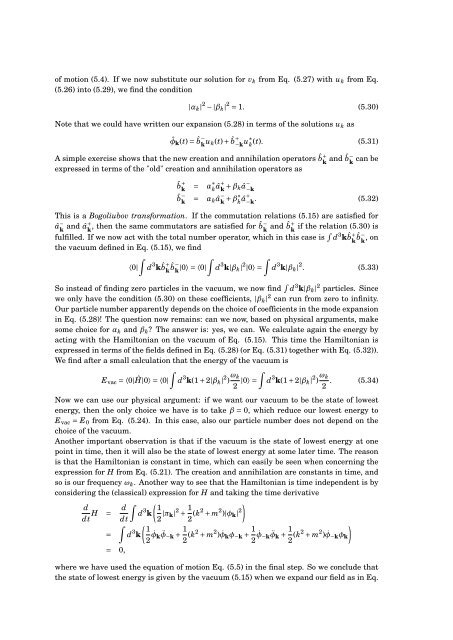Master's Thesis in Theoretical Physics - Universiteit Utrecht
Master's Thesis in Theoretical Physics - Universiteit Utrecht
Master's Thesis in Theoretical Physics - Universiteit Utrecht
Create successful ePaper yourself
Turn your PDF publications into a flip-book with our unique Google optimized e-Paper software.
of motion (5.4). If we now substitute our solution for v k from Eq. (5.27) with u k from Eq.(5.26) <strong>in</strong>to (5.29), we f<strong>in</strong>d the condition|α k | 2 − |β k | 2 = 1. (5.30)Note that we could have written our expansion (5.28) <strong>in</strong> terms of the solutions u k asˆφ k (t) = ˆb − k u k(t) + ˆb + −k u∗ k(t). (5.31)A simple exercise shows that the new creation and annihilation operators ˆb + k and ˆb − can bekexpressed <strong>in</strong> terms of the "old" creation and annihilation operators asˆb + k= α ∗ kâ+ k + β kâ − −kˆb − k= α k â − k + β∗ kâ+ −k . (5.32)This is a Bogoliubov transformation. If the commutation relations (5.15) are satisfied forâ − k and â+ k , then the same commutators are satisfied for ˆb − k and ˆb + if the relation (5.30) iskfulfilled. If we now act with the total number operator, which <strong>in</strong> this case is ∫ d 3 k ˆb + ˆb − k k , onthe vacuum def<strong>in</strong>ed <strong>in</strong> Eq. (5.15), we f<strong>in</strong>d∫∫∫〈0| d 3 k ˆb + ˆb − k k |0〉 = 〈0| d 3 k|β k | 2 |0〉 = d 3 k|β k | 2 . (5.33)So <strong>in</strong>stead of f<strong>in</strong>d<strong>in</strong>g zero particles <strong>in</strong> the vacuum, we now f<strong>in</strong>d ∫ d 3 k|β k | 2 particles. S<strong>in</strong>cewe only have the condition (5.30) on these coefficients, |β k | 2 can run from zero to <strong>in</strong>f<strong>in</strong>ity.Our particle number apparently depends on the choice of coefficients <strong>in</strong> the mode expansion<strong>in</strong> Eq. (5.28)! The question now rema<strong>in</strong>s: can we now, based on physical arguments, makesome choice for α k and β k ? The answer is: yes, we can. We calculate aga<strong>in</strong> the energy byact<strong>in</strong>g with the Hamiltonian on the vacuum of Eq. (5.15). This time the Hamiltonian isexpressed <strong>in</strong> terms of the fields def<strong>in</strong>ed <strong>in</strong> Eq. (5.28) (or Eq. (5.31) together with Eq. (5.32)).We f<strong>in</strong>d after a small calculation that the energy of the vacuum is∫E vac = 〈0|Ĥ|0〉 = 〈0|d 3 k(1 + 2|β k | 2 ) ω k2 |0〉 = ∫d 3 k(1 + 2|β k | 2 ) ω k2 . (5.34)Now we can use our physical argument: if we want our vacuum to be the state of lowestenergy, then the only choice we have is to take β = 0, which reduce our lowest energy toE vac = E 0 from Eq. (5.24). In this case, also our particle number does not depend on thechoice of the vacuum.Another important observation is that if the vacuum is the state of lowest energy at onepo<strong>in</strong>t <strong>in</strong> time, then it will also be the state of lowest energy at some later time. The reasonis that the Hamiltonian is constant <strong>in</strong> time, which can easily be seen when concern<strong>in</strong>g theexpression for H from Eq. (5.21). The creation and annihilation are constants <strong>in</strong> time, andso is our frequency ω k . Another way to see that the Hamiltonian is time <strong>in</strong>dependent is byconsider<strong>in</strong>g the (classical) expression for H and tak<strong>in</strong>g the time derivativeddt H = d ∫ ( 1d 3 kdt 2 |π k| 2 + 1 )2 (k2 + m 2 )|φ k | 2∫ ( 1= d 3 k2 ˙φ k ¨φ−k + 1 2 (k2 + m 2 ) ˙φk φ −k + 1 2 ˙φ −k ¨φk + 1 )2 (k2 + m 2 ) ˙φ−k φ k= 0,where we have used the equation of motion Eq. (5.5) <strong>in</strong> the f<strong>in</strong>al step. So we conclude thatthe state of lowest energy is given by the vacuum (5.15) when we expand our field as <strong>in</strong> Eq.
















